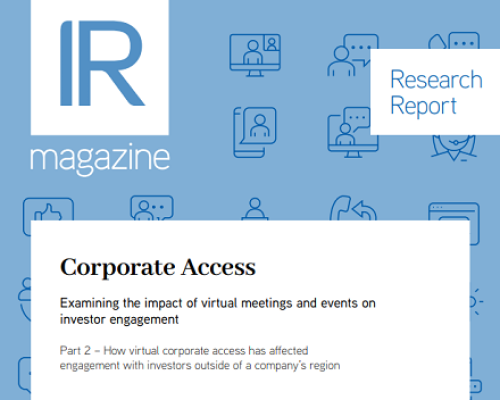More changes afoot on Wall Street as brokers vie for market share, while agency-only brokers increasingly offering access to management
A function that has historically been dominated by some of the world’s best-known investment banks, corporate access departments are being assembled by countless new players looking to bolster their service to buy-side clients.
Corporate access is a lucrative business. In 2008 the commissions allocated to it totaled more than $2 bn, according to data from Greenwich Associates. Rick Hanley, chairman and CEO of Hanley & Associates, thinks the figure for 2009 could be lower, however. ‘Early indications are that it may be down 20 percent in terms of general overall commissions,’ he says.
‘We are seeing more firms doing corporate access,’ says Michael Mayhew, chairman and global director of research at Integrity Research Associates. ‘Many have wanted to find out how they can get paid more for execution and one obvious way is to provide more value and offer research. The buy side perceives the management access as part
of the research product.’
New players
Agency brokerage firms that have traditionally made their bread and butter through trading have also now latched on to the larger commissions available by adding management access to their range of buy-side services. Agency-only brokers like WJB Capital Group, Bay Crest Partners, Execution and Knight Capital are all offering corporate access, and dark pool Liquidnet made its first foray into corporate access in conjunction with NYSE when it launched InfraRed last year.
ConvergEx has also entered the space: both it and Knight Capital feature in the top 10 traders by volume on NYSE Euronext (see NYSE Euronext broker volume, below).
The obvious repercussion is an increase in choice for corporates, but the difficulty comes in determining which firm to go on the road with. The nature of the commission structure is also likely to affect the kinds of investors issuers are taken to see. Do corporates worry they could end up having meetings with the very investors that are causing volatility in their stock?
‘A lot of issuers ask us that question,’ notes Guy Gresham, vice president of the global IR advisory team at BNY Mellon. Gresham and his team are currently trying to quantify and understand the commission sharing and cost structure underlying a trade and what this could mean for issuers. It’s no easy task, however, as even agency-only brokers sometimes find it hard to keep tabs on their commission levels. It becomes harder still if brokers conduct research, corporate access and execution.
‘Either they have a trading desk, which means they are paid through execution, or they get subscriptions, which counts as soft dollars,’ Mayhew explains, adding that the client commission arrangements (CSA) mechanism
is becoming increasingly prevalent in the US. The CSA mechanism is similar to the ‘soft dollar’ mechanism. Mayhew estimates about 20 percent of commissions are flowing through CSA arrangements in the US, a trend that started in earnest in 2006 after the SEC issued its 28E interpretative guidance, defining soft dollars.
Previous surveys of hedge fund clients reveal millions have been paid to secure access to key management members – and it’s a service the buy side dearly values. ‘We’ve heard estimates of $5,000-$20,000 a meeting,’ says Bill Sherman, Ipreo’s global head of data strategy and analytics. ‘Some of the participants on the buy side involved in requesting meetings think they get the service for free as they have to trade anyway, without really understanding that a portion of the commissions paid are being
justified against access.’
The fragmented landscape demands a greater amount of savvy on the part of issuers. ‘Some firms have decided to do their own investor outreach because investors didn’t want to go through a broker and pay commission,’ Gresham says. ‘We are also seeing clients looking to use more than one broker on a trip to the US. They may use one broker in one place and look to use another in a different area.’
NASDAQ broker share volume report
From October 1 to December 31, 2009
Rank Company Share volume (bn)
1 Wedbush Morgan Securities 29
2 Knight Equity Markets 27
3 Citigroup Global Markets 25
4 UBS Securities 23
5 Citadel Securities 22
6 Goldman Sachs 17
Source: NASDAQ
NYSE Euronext broker volume
From October 1 to December 31, 2009
Rank Company Share volume (bn)
1 Goldman Sachs 22
2 Morgan Stanley 17
3 Merrill Lynch 15
4 ConvergEx 10
5 Credit Suisse 8
6 Knight Capital Markets 8
Source: NYSE Euronext










